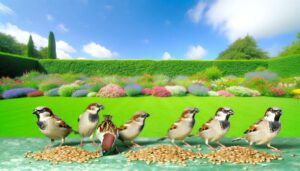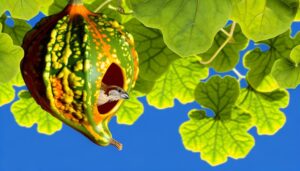Understanding How House Sparrows Cause Ecological Harm
House sparrows cause ecological harm by aggressively competing with native bird species for resources such as food and nesting sites. Their presence leads to reduced reproductive success and survival rates among native birds.
They also act as vectors for diseases and parasites, which threaten local avian populations and broader ecosystems. In agricultural settings, they consume and contaminate crops, causing economic losses.
Additionally, sparrows disrupt urban ecosystems and contribute to genetic pollution through hybridization. Their impact on insect populations disrupts food webs, highlighting the need for effective management strategies.
Discover more about mitigating these ecological threats.

Key Takeaways
- House sparrows deplete food resources, reducing availability for native bird species.
- They aggressively take over nesting sites, displacing and injuring native birds.
- House sparrows spread diseases and parasites, threatening native bird populations.
- Their consumption and contamination of crops lead to economic losses for farmers.
- House sparrows contribute to genetic pollution through hybridization with native species.
Competition for Food
House sparrows (Passer domesticus) have a significant impact on native bird species by competing for limited food resources, often outcompeting them for seeds and insects. Evidence suggests that their aggressive foraging behavior leads to significant depletion of available food supplies, disadvantaging native species with less competitive foraging strategies.
Studies have shown a correlation between high house sparrow densities and reduced populations of native birds, indicating direct competition. House sparrows' broad diet allows them to exploit various food sources, further exacerbating resource scarcity. Such competition can result in decreased reproductive success and survival rates for native species, thereby disrupting local ecosystems.
Understanding this dynamic is essential for developing effective conservation strategies to mitigate the ecological harm caused by house sparrows.
Nesting Site Takeover
In addition to competing for food, house sparrows also exert substantial pressure on native bird populations by aggressively taking over nesting sites. This behavior has several detrimental effects on local avifauna, leading to significant ecological implications.
The following factors illustrate the impact of house sparrows' nesting site takeover:
- Displacement: Native species are often forcibly evicted from their nests, resulting in loss of habitat.
- Reduced Breeding Success: Displacement can lead to decreased reproductive success among native birds.
- Physical Altercations: House sparrows engage in aggressive behaviors, sometimes causing injury or death to native birds.
- Nest Destruction: They may destroy the eggs and chicks of native species, further diminishing their populations.
These behaviors collectively contribute to the ecological imbalance caused by house sparrows.
Decline in Native Birds
The proliferation of house sparrows (Passer domesticus) has been correlated with a marked decline in native bird populations, primarily through competition for nesting sites.
Their aggressive behavior towards native species often results in direct displacement, hindering the reproductive success of local birds.
Consequently, this has led to a notable disruption in the ecological balance within affected habitats.
Competition for Nesting Sites
Competition for nesting sites has been identified as a significant factor contributing to the decline in native bird populations due to the invasive nature of house sparrows. These birds aggressively compete for limited nesting locations, frequently displacing indigenous species. This competition results in several detrimental effects on native birds:
- Reduced Breeding Success: Native birds are often forced to abandon their nests, leading to lower reproductive rates.
- Habitat Displacement: Native species are driven out of their preferred habitats, causing stress and reducing population stability.
- Nest Usurpation: House sparrows take over existing nests, destroying eggs and young of native birds.
- Resource Depletion: Competition for nesting sites also extends to food resources, further straining native bird populations.
These factors collectively contribute to the decline in native bird species.
Aggressive Behavior Towards Natives
House sparrows exhibit aggressive behaviors such as physical attacks and intimidation tactics towards native bird species, conspicuously contributing to their decline. Empirical studies have shown that these sparrows engage in frequent confrontations, often resulting in injury or death of indigenous birds. Additionally, house sparrows are known to destroy the eggs and nests of native species, thereby reducing their reproductive success.
This aggressive behavior disrupts the breeding cycles and habitat stability of species such as bluebirds and swallows. The competitive pressure exerted by house sparrows can lead to significant decreases in native bird populations, as these endemic species are unable to effectively compete with the more aggressive and adaptable sparrows.
Consequently, this dynamic poses a substantial threat to biodiversity.
Displacement of Local Species
Invasive house sparrows have been documented to substantially displace local bird species, leading to observable declines in native avian populations. This displacement is primarily attributed to direct competition for nesting sites and food resources. Scientific studies have highlighted several detrimental impacts:
- Competition for Nesting Sites: House sparrows aggressively occupy and defend nesting sites, often excluding native birds.
- Food Resource Depletion: They outcompete native species for food, reducing available resources.
- Breeding Interference: House sparrows disrupt the breeding cycles of native birds, leading to decreased reproductive success.
- Habitat Modification: Their presence can alter local ecosystems, making habitats less suitable for indigenous species.
These factors collectively contribute to the decline of native bird populations, emphasizing the ecological threat posed by house sparrows.
Spread of Diseases
House Sparrows act as vectors for various pathogens, facilitating disease transmission pathways that can affect both avian and human populations. Studies have shown that these birds can carry and spread diseases such as avian malaria and West Nile virus, leading to significant health impacts.
Consequently, the spread of these diseases poses a considerable threat to native bird species, contributing to their decline and ecological imbalance.
Disease Transmission Pathways
Through various interactions with other species and environments, house sparrows serve as vectors for the transmission of numerous infectious diseases. These birds are known to harbor and spread pathogens that can affect both avian and human populations.
The mechanisms of disease transmission are multifaceted:
- Direct Contact: Sparrows can transmit diseases through direct physical contact with other birds or humans.
- Fecal Contamination: Their droppings can contaminate food and water sources, spreading pathogens like Salmonella.
- Parasite Vectors: Sparrows can carry ectoparasites such as mites and lice, which in turn can transmit diseases.
- Airborne Particles: Diseases like avian influenza can be spread through respiratory droplets released by infected sparrows.
These pathways highlight the significant role house sparrows play in disease ecology.
Impact on Native Species
The spread of diseases by house sparrows poses a significant threat to native avian species, leading to population declines and disruptions in local ecosystems.
House sparrows are vectors for various pathogens, including avian pox and Salmonella spp., which can infect and decimate native bird populations. Studies have documented instances where these diseases have led to substantial declines in native species, such as bluebirds and swallows.
The transmission is facilitated by the sparrows' close association with human habitation, increasing contact with native species at feeders and nesting sites. The result is not only a loss of biodiversity but also a potential alteration of ecosystem dynamics, as the decline of native birds can affect pollination, seed dispersal, and insect population control.
Parasite Transmission
Transmitting a variety of parasites, house sparrows can greatly impact the health of native bird populations and the broader ecosystem. These introduced species can be vectors for numerous pathogenic organisms, leading to increased disease prevalence among indigenous avifauna.
Key parasites associated with house sparrows include:
- Plasmodium relictum: A causative agent of avian malaria, which can be lethal to many native bird species.
- Haemoproteus spp.: Blood parasites that can weaken birds, reducing their reproductive success and survival rates.
- Sternostoma tracheacolum: A respiratory mite that can cause severe respiratory distress in infected birds.
- Coccidia: Intestinal parasites that can lead to gastrointestinal illness, impairing nutrient absorption and overall health.
The introduction of these parasites disrupts native ecosystems, potentially leading to declines in native bird populations.
Agricultural Impact
House sparrows pose significant challenges to agricultural systems by consuming and contaminating crops, leading to economic losses for farmers. These birds feed on a variety of grains, fruits, and seeds, reducing the yield available for human consumption. Research indicates that their feeding behavior can cause substantial damage to staple crops like wheat and rice.
Additionally, house sparrows can introduce pathogens and parasites through their droppings, which contaminate stored grains and other agricultural products. This contamination not only reduces the market value of the crops but also poses health risks to consumers. Effective management strategies are essential to mitigate these impacts and guarantee sustainable agricultural productivity.
Techniques such as habitat modification and exclusion methods are commonly employed to control their populations.
Urban Ecosystem Disruption
Urban ecosystems face severe disruption from house sparrows, known for their invasive behavior. These disruptions are multifaceted:
- Resource Competition: House sparrows outcompete native birds for food sources, leading to relocation or starvation of the latter.
- Nesting Site Domination: They aggressively claim nesting sites, depriving native birds of breeding spots.
- Disease Transmission: Sparrows can transmit diseases, adversely affecting native bird populations.
- Biodiversity Decline: The aggressive nature of house sparrows results in reduced avian biodiversity, upsetting the ecological equilibrium.
These factors collectively pose a threat to urban ecosystems' stability and the survival of native species.
Genetic Pollution
The invasive presence of house sparrows not only disrupts urban ecosystems but also contributes to genetic pollution by hybridizing with native bird species, thereby diluting the genetic integrity of local avian populations. Genetic pollution occurs when the gene pool of native species is altered through interbreeding with introduced species, leading to the loss of unique genetic traits and potentially reducing the fitness of hybrid offspring.
Scientific studies have documented instances where hybridization between house sparrows and indigenous birds has resulted in reduced reproductive success and compromised survival rates. This genetic interference threatens the conservation of native species and complicates efforts aimed at maintaining biodiversity. Consequently, the genetic homogenization induced by house sparrows poses a significant ecological threat.
Impact on Insect Populations
Several studies have indicated that the proliferation of house sparrows greatly impacts local insect populations, often leading to a decline in certain insect species. These declines can have cascading effects on the ecosystem, affecting biodiversity and ecological balance.
House sparrows primarily prey on insects during their breeding season, targeting:
- Caterpillars – Essential for many butterfly species' life cycles.
- Beetles – Important decomposers in various habitats.
- Spiders – Key predators in controlling other insect populations.
- Grasshoppers – Essential for plant pollination and soil health.
The reduction in these insect populations can disrupt food webs and reduce the availability of these insects for native bird species, further exacerbating ecological imbalances.
Monitoring and managing house sparrow populations is thus essential for maintaining local biodiversity.
Conclusion
The house sparrow, via competition for food and nesting sites, has led to a decline in native bird populations and disrupted urban ecosystems. Additionally, this species facilitates the spread of diseases, transmission of parasites, and genetic pollution. Its presence also negatively impacts insect populations and agriculture.
Consequently, the house sparrow acts as a double-edged sword, simultaneously thriving while causing significant ecological harm. These findings underscore the necessity for effective management strategies to mitigate its adverse effects.






